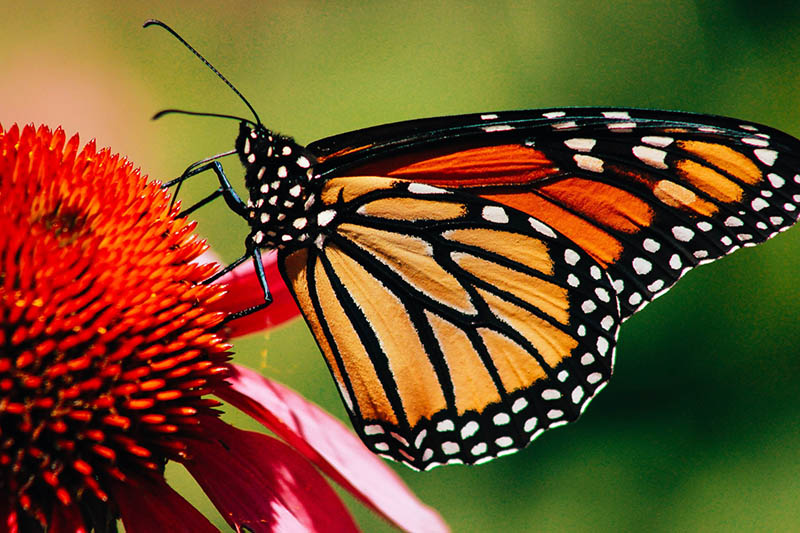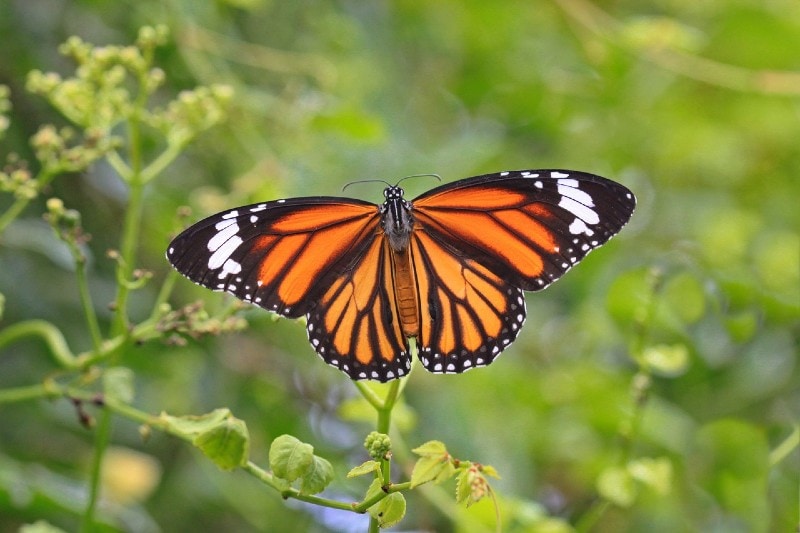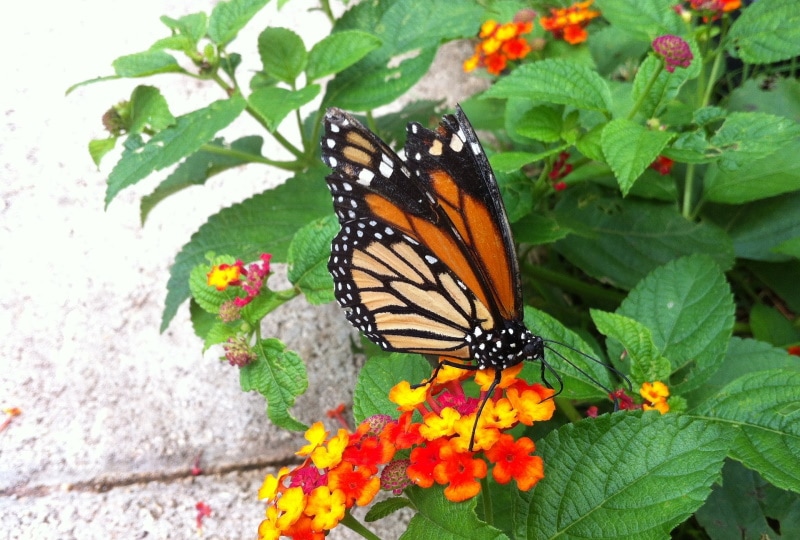What Is the State Insect of Idaho? Reasons, History, & Symbolism
-
Pete Ortiz
- Last updated:

Known for potato production, Idaho is one of the largest agricultural states in the USA. In 2021 Idaho farmers harvested over 14.4 million pounds of potatoes¹ from over 322,000 acres. That is not all; it is home to some of the most dramatic geographical features. Boise mountain towering over 10,000 feet above sea level, deep valleys, waterfalls, and lava tubes shape the state.
Far from the bustling metropolis is an untamed and protected natural habitat to cutthroat trout (the state fish), woodland caribou, pygmy shrews, and the legendary monarch butterfly, which happens to be Idaho’s official state insect.
How Did the Monarch Butterfly Become Idaho’s State Insect?
The monarch butterfly was designated as the state insect in 1992 after a group of 4th-grade students and their teacher from Cole Elementary School, Boise, dressed up as monarchs, persuaded the legislature to name it the state insect. 17 years earlier, Illinois had adopted it as a state insect in 1975, followed by Vermont and Alabama in 1987 and 1989, respectively. Following Idaho’s example, Texas and Minnesota designated it as their first state insect in 1995 and 2000, respectively. Cumulatively, the butterfly is the official insect of seven states.

Is the Monarch Butterfly a True Monarch?
If your definition of monarchism is all about beauty, the monarch butterfly is a true monarch. Earliest settlers, possibly from England, named the monarch to honor King William, and its vibrant colors give us the reasons. The monarch has two pairs of deep orange and pale orange wings, which are almost 4 inches across.
Depending on the species, males’ wings are deep orange, while females are light orange with black veins. Borders are also black and bear distinctive white spots, which look similar to the design style used on that era’s king’s outfits.
The Monarch Butterfly
At a closer look, females’ venation is thicker than males. However, males have two dark spots at the center of their wings. These are scent glands that release pheromones.
Generally, the butterfly’s body (head, thorax, and abdomen) is 1 to 3 inches long and weighs less than 0.1 ounces.
From laying eggs to adulthood, monarchs go through complete metamorphosis. In this biological process, the egg hatches into larvae which pupate before emerging as an adult butterfly.
Mating occurs in two phases. The first phase involves males identifying a flying female and forcing her onto the ground, where the second phase of copulation occurs. Females will then lay eggs on milkweed in spring. Depending on the temperature, the egg will hatch after 20 to 33 days (warmer temperatures accelerate the process). The resulting larvae or caterpillars are brightly colored in alternating white, black, and yellow stripes. Within the next 2 weeks, they will quench their ferocious appetite on milkweed leaves, grow to about two inches long and pupate.
The flashy coloration is a warning sign to predators to stay away because the milkweed the caterpillar feeds on contains toxic compounds known as glycosides. The caterpillar and mature adults store enough glycosides capable of killing small predators.
After the miraculous transformation, adults burst out of their cocoons in transparent coats and soft wings. Within the next few hours, the butterfly will pump blood into the wings and wait for them to stiffen up before setting off to feed on nectar.
To survive through winter, adult monarchs gather in spectacular groups and migrate to warmer places in the south. Western monarchs (those that mate and lay eggs on the western side of the Rockies) travel to overwintering sanctuaries in California, while the Eastern population head for the Mariposa Monarca biosphere reserve in Michoacán, Mexico. During the mind-boggling migration, millions die on the way due to the lack of trees for food caused by increasing forest fires in California. But the good news is, some monarchs are staying all year round in California and won’t endure the twice-a-year migration to and from the Rockies. Of course, this is bad news for Idaho since summer visits to the region are dwindling.

Is the Monarch Butterfly a National Insect?
Congress once proposed the monarch to be a national insect in the mid-80s, but unfortunately, the bill failed to pass in 1989. A second attempt in 1991 also met the same fate.
Will Idaho Lose Its Prized Butterfly to Extinction?
Once a common sight, monarch numbers have plummeted to be red-listed by IUCN. These extinction threats are growing bigger by the day. If something is not done, no monarchs will be crowned in Idaho in a few years to come.
Legal and illegal logging to pave space for agriculture and urban development have shrunk their number from between 20% and 72% in the USA and some parts of Canada. Cutting down trees reduces nectar production, their main source of food.
Increased use of pesticides and herbicides is killing both mature butterflies and young caterpillars. Lastly, severe weather patterns such as drought and hurricanes affect milkweed availability and decimate mature butterflies.
How Can We Help Idaho Save Monarchs?
While Idaho only hosts monarchs for a few months, saving them is a cumulative responsibility.
1. Create a butterfly garden
A butterfly garden grows plants that provide food for a mature monarch or its offspring. Plant one of the 13 species of milkweed, such as standard, green, poke, purple, and spider. They will host young monarch caterpillars in summer.

2. Reduce the use of pesticides and herbicides
These groups of farm chemicals are harmful to the ecosystem, and their usage should be restricted. Spray sparingly, avoiding milkweeds and flowers if you are to use them. For weed control, use friendly methods such as uprooting, and leave one of every two milkweeds along the way.
3. Educate others to help monarchs on their migration route
Flapping their tiny wings for more than 3,000 miles to Mexico requires a lot of energy. Luckily, monarchs soar on air currents when the conditions are favorable. This is not always the case, and monarchs have to use energy.
Educate people on their migratory routes to plant more flowering trees that will replenish them on their way.
Conclusion
Monarch butterflies are Idaho’s and six other official state insects. They were crowned with these prized titles in 1992 thanks to the efforts of Cole Elementary School 4th grade students. The butterfly is beautiful with orange wings and migrates to Florida, California, and Mexico from Idaho each year.
Unfortunately, deforestation, climate change, and farm chemicals are reducing their population. Plant milkweed and limit the use of farm chemicals in their habitat to help save their kingdom.
See also:
- https://www.papertrell.com/apps/preview/The-Handy-Science-Answer-Book/Handy%20Answer%20book/Has-the-United-States-selected-a-national-insect/001137021/content/SC/52cb040782fad14abfa5c2e0_default.html
- https://www.usnews.com/news/best-states/idaho#:~:text=Idaho%20is%20as%20well%20known,for%20its%20unspoiled%2C%20rugged%20landscapes
- https://idahopotato.com/dr-potato/maine-vs-idaho-potatoes-in-production
- https://www.statista.com/statistics/382166/us-potato-production-by-state/
Featured Image Credit: Erin Minuskin, Unsplash
Contents


